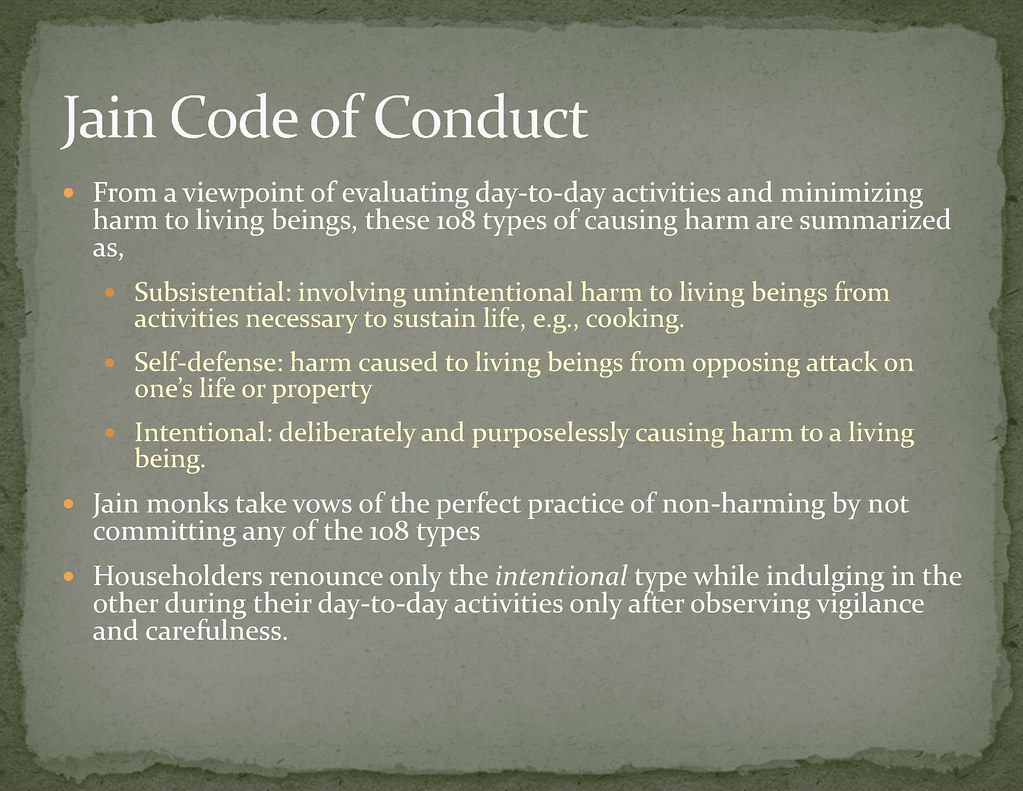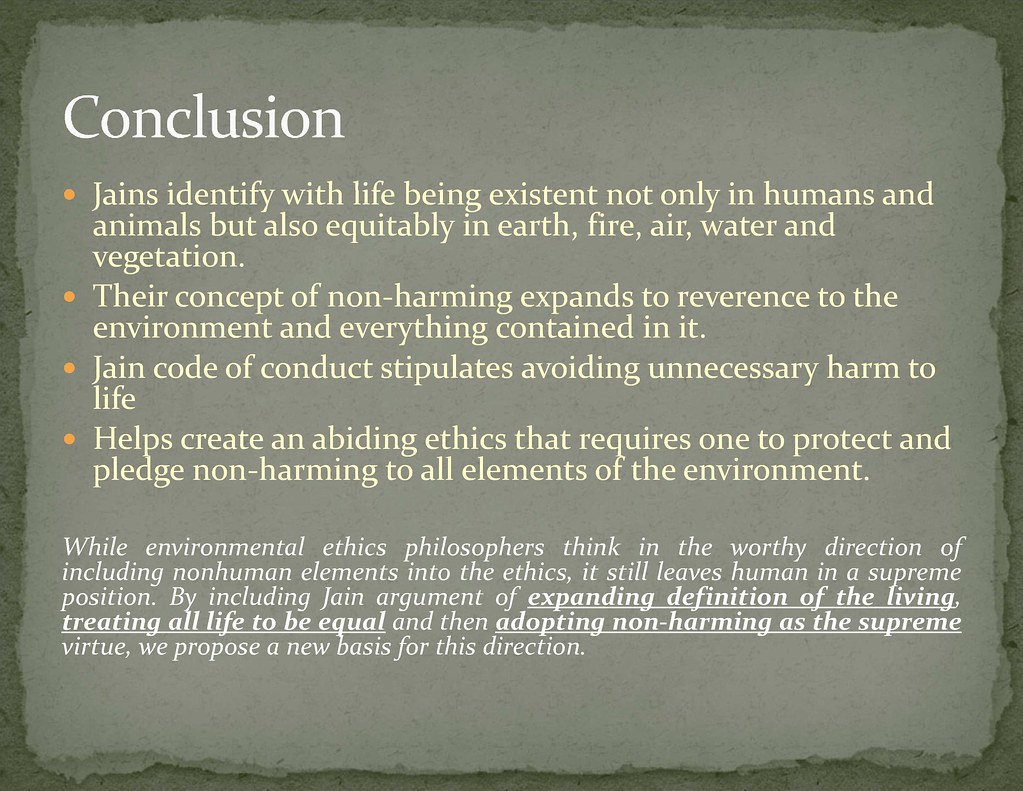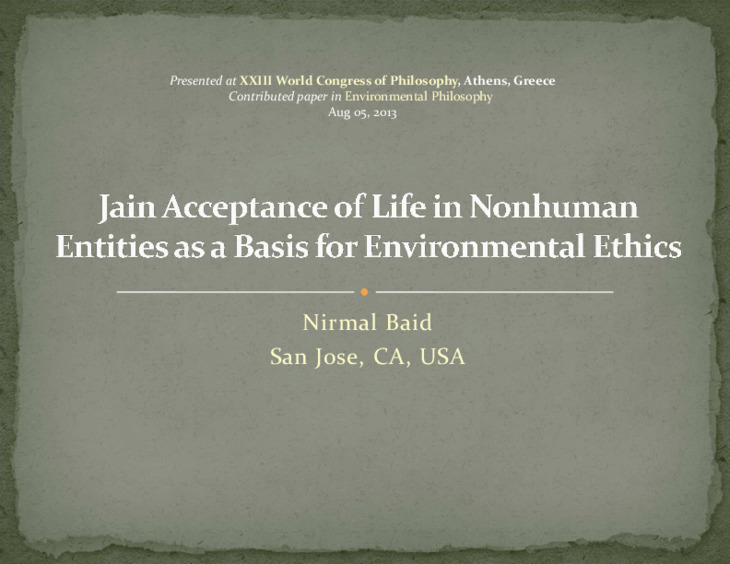The Paper
Jain Acceptance of Life in Nonhuman Entities as a Basis for Environmental Ethics
Dr. Nirmal Baid, San Jose, CA, USA
Research paper presented at, XXIII World Congress of Philosophy, Athens, Greece
Contributed paper in Environmental Philosophy Aug 05, 2013
Abstract
Environmental ethics as a discipline deals with the morality of human actions and its consequences on the environment and its nonhuman elements. It addresses the question of whether there is a moral implication of harming the nonhuman contents of the environment - animate or inanimate. Jains identify with life being existent not only in humans and animals but also equitably in earth, fire, air, water and vegetation. Life in these seemingly inanimate objects is considered at par with human or animal life form. Code of conduct for Jain householders and monks alike stipulates avoiding unnecessary harm to life including these inanimate life forms. When the entire world around us comes alive, this code of conduct helps create an abiding ethics that requires one to protect and pledge non-harming to all elements of the environment we live in.
1
Brennan and Lo[1] define environmental ethics as a "...discipline in philosophy that studies the moral relationship of human beings to, and also the value and moral status of, the environment and its nonhuman contents". Traditional western ethical thinking is primarily based on human-centeredness commonly referred to as anthropocentrism. Current thought on environmental ethics, whether anthropocentric or even non-anthropocentric finds its roots in the idea that human species is supreme. These systems either assign an intrinsic supremacy to human beings alone in the sense that all nonhuman entities are disposable, or they assign a significantly greater amount of value to human beings than to any nonhuman entities. In either case the protection of human interests at the expense of nonhuman entities becomes nearly always justified. There is nothing inherent that gives nonhumans a standing on their own.
Within the context of anthropocentrism, an argument to treat nature as a system of resources that must be preserved and protected is presented by Passmore[2], however, a line is drawn by saying, "if men were ever to decide that they ought to treat plants, animals, landscapes precisely as if they were persons, if they were to think of them as forming with man a moral community in a strict sense, that would make it impossible to civilize the world - or, one might add, to act at all or even to continue living[3]. Numerous thinkers have made a case for a moral community with nature insisting on unifying links between human beings and nature, an important one being Aldo Leopold. Leopold[4] suggests that throughout the history of ethics there has been an underlying theme of morality from which an ethic for nature can evolve. His case for the Land Ethic arises out of a criticism of a purely economic way of viewing the Land. He sees the Land as a system with interconnected chains and recognizes that all species are ecologically valuable, and that we are likely to never fully understand the relations between things that enable ecological systems to be sustained.
The challenge however is that just extending human ethics to include nature is not enough and because in traditional thinking nonhuman elements of the environment are not moral objects in the way humans are. Sylvan in his essay[5] argues that it is not enough to extend the ethics to include other elements of environment; rather we need a new environment ethics. This argument is supported by Taylor[6] in presenting a view that all living things have inherent value, hence are equally deserving of moral respect. For him, all that is required to have inherent value is to be alive, and he takes a position that well-being of all living things is of primary concern. Hence, while his position is non-anthropocentric, Taylor does not include all nonhuman entities in his definition of being alive.
Goodpaster[7] posits that morality is based on the capacity to suffer, and argues for a life centered environmental ethic. His point is that even though the capacity to suffer as a result of sentience may be a sufficient condition for having moral standing, he sees no reason for thinking that it is necessary. Singer[8] also contends sentience as the criterion of moral importance simply based on the thesis that granting moral consideration to human only is completely arbitrary. Singer's thesis is that we need to extend to nonhumans (primarily pointed to animals) the same equality of consideration that we extend to humans.
The Gaia theory[9] emphasizes interconnectedness and interdependence among various elements of the environment. Chapple presents a comparison of the Gaia theory and the Jain thought[10] where he draws parallel between the two and concludes that while both address the issue of ethical nature, however, "...the ethics implied by Gaia is unformed, though an ethic that mandates reducing harm to the environment seems inescapable."
The question is whether an ethical system can simply be based on the prevailing concept of morality or a strong basis needs to be established for the system to deem nonhuman entities at par with humans. We argue for the latter, while attempting to formulate a basis for creating a non-anthropocentric environmental ethic founded on Jain philosophy, which postulates a radical definition of what constitutes sentience and delve deep into how harm on sentient beings needs to be renounced.
2
Jains believe their knowledge of universe has existed for eternity; the current Jain thought, however, traces its lineage back to Mahavir (500 BCE). Jains classify the universe into a dualistic system of living and nonliving beings[11],[12]. A living being (Sanskrit - Jiv, and is often translated as soul) possesses certain inherent characteristics, a crucial one being possession of consciousness[13],[14]. This property belongs to a living being no matter how developed or undeveloped it is.
Jains posit that a living being or soul suffers because of the fruits of its actions. The principle of not harming other souls is central to Jain thought as this violence towards living beings is what results into suffering for oneself. A soul goes through the cycle of birth and death as a result of these actions, and a Jain practitioner aspires to a path where one gets rid of all these accumulated actions (karmas) from the past and vows to non-passionate activity to minimize harming any living being so as not to accumulate more negative karmas. Until all accumulated karmas are gotten rid of, full potential of a soul is not experienced[15].
Five types of living beings are identified in Jain Philosophy -- from one sensed to five sensed[16]. In the one sensed being, there is a further classification to endow earth, water, fire, air and vegetation with a soul that is at its essence no different than a soul of animals, humans or even a fully liberated being. This puts these seemingly inanimate objects at par with being a life form as precious as any other[17]. Distinction is made to ensure a living being with water, fire, air and earth body is not confused with a being living in one of these mediums. For example, a soul with earth body is distinct from an earthworm or a bacteria living in the earth. One sensed beings only have the sense of touch[18], and are further subdivided into five categories[19]: Earth-bodied, Water-bodied, Fire-bodied, Air-bodied, and Plant-bodied.
All living beings are endowed with ten possible vitalities[20],[21], the number varying with the stages of development. The ten vitalities are -- five senses, namely, touch, taste, smell, sight and hearing, respiration, lifespan, body, speech and mind. One sensed beings have four vitalities, touch, body, respiration and lifespan, while the five sensed beings with mind such as humans have all the ten vitalities. Each of these living beings is considered as sentient as any other and minimizing harm to them is of supreme concern for a Jain.
3
As mentioned before, Jains postulate that a living being suffers fruits of its actions. The fruits result in suffering especially if the actions cause harm to other living beings. For this reason, Jain thinkers have delved deep into understanding the concept of non-harming (Sanskrit - Ahimsa, also translated as nonviolence), and went as far as identifying all possible behaviors that could cause harm to other living beings so that those are avoided in daily conduct. Every living being whether a human, an animal, a worm, or a tree desires to have free experience of all its vitalities and any intervention in such experience causes violence to that living being.
Jains distinguish two constituents that make up violence - first, injury to the vitalities of a living being, and second, the passionate activity that leads to it[22]. It should be noted that the first alone may not constitute harm especially when the motives behind causing injury are good, for example, when a doctor performing surgery may injure vitalities by causing pain, but it will not be considered violence.
Since a passionate activity is considered the root cause of the harm caused to living beings, Jains have deliberated this in detail. There are three stages of an act namely, planning, preparation and execution. Motivation behind each of these stages could be due to any one of the four passions viz., anger, pride, deceit and greed. Further, the harm may be caused by three modes - through one's mind, speech or body. Furthermore, that harm can be committed through three methods -- either committed by oneself or one may make others to commit it on their behalf or, one may approve of someone else doing it. This gives a total of 108 combinations of ways of causing harm - for instance -one may mentally plan to have someone cut a tree out of their greed. This passionate activity is in planning stage, driven by greed, is a mental activity and is being planned to be committed by someone else on one's behalf.
4
For simplicity, these 108 types of causing harm has been classified in the following three categories from a viewpoint of evaluating day-to-day activities and minimizing harm to living beings.
- Subsistential: involving unintentional but indirect harm to living beings from activities necessary to sustain life, e.g., cooking.
- Self-defense: harm caused to living beings from opposing attack on one's life, property or state.
- Intentional: deliberately and purposelessly causing harm to a living being.
Jain monks take vows of the perfect practice of non-harming by not committing any of the 108 types of violence mentioned. A Jain monk does not plan or prepare or execute with anger or pride or deceit or greed by mind or body or speech either himself or through another or approve committing any act which injure any of the ten vitalities of any living being. This is complete non-harming. From the three types mentioned above, monks renounce all the three types, and householders renounce only the intentional type while indulging in the other during their day-to-day activities only after observing vigilance and carefulness.
Since Jains posit that life is contained in every object of the environment, the concept of non-harming expands to reverence to the entire universe and everything contained in it. No other religion has as consistently and broadly stressed reverence for "all" life form as much as Jains have[23]. The destruction of environment as happening today primarily brought about by the modern civilization will be unthinkable in a Jain society. While absolute non-harming is not possible, Jains are uncompromising in this regard to allow any more than what is minimally required. The Jain code of conduct has provided for various guidelines on what is absolutely necessary in terms of one's goals and stages of development.
While environmental ethics philosophers are thinking in the direction of including nonhuman elements into the ethics, it still leaves human in a supreme position. By including Jain argument of expanding definition of the living, treating all life to be equal and then adopting non-harming as the supreme virtue, we propose a new basis for this direction.
The Presentation
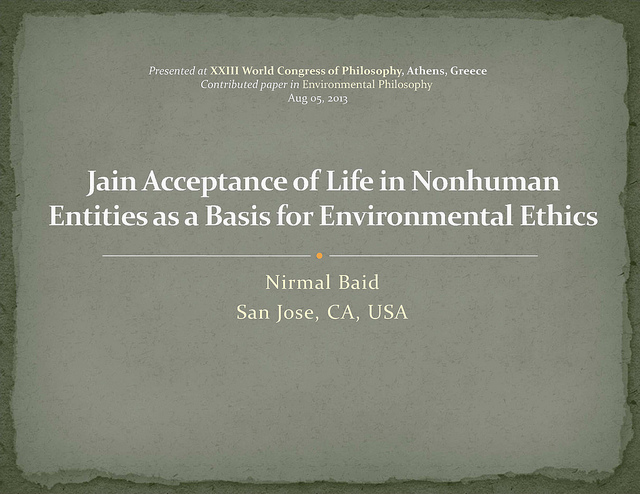
 www.herenow4u.net/index.php?id=95811
www.herenow4u.net/index.php?id=95811
 www.herenow4u.net/index.php?id=95811
www.herenow4u.net/index.php?id=95811
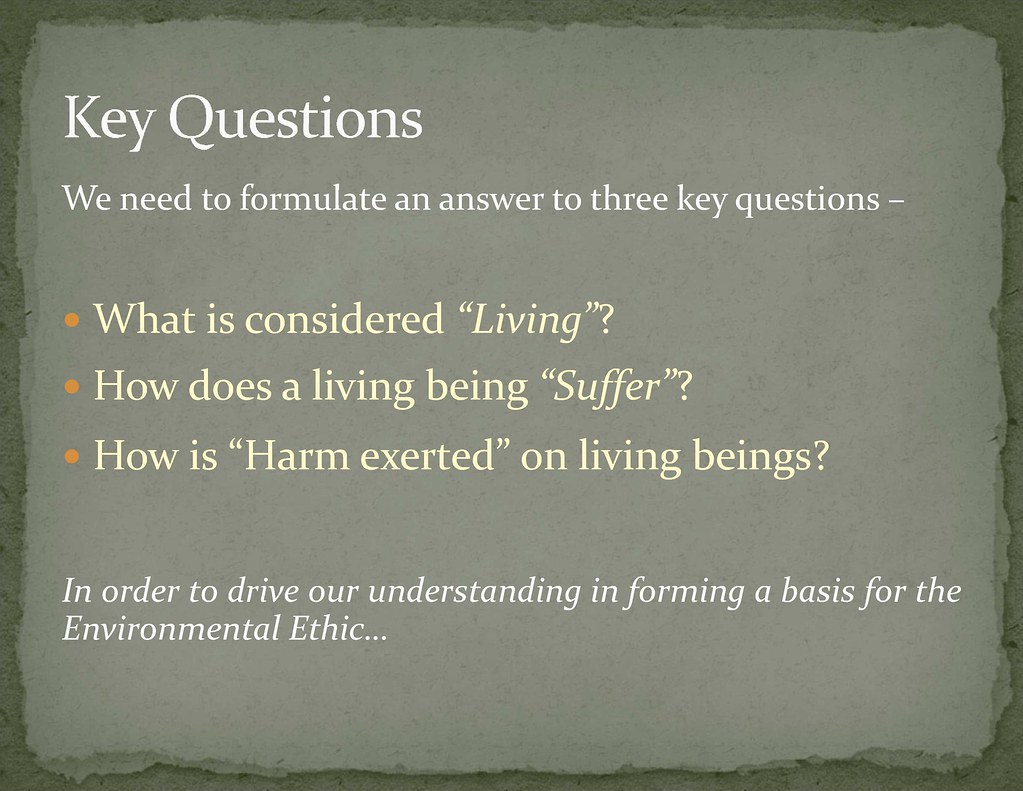 www.herenow4u.net/index.php?id=95811
www.herenow4u.net/index.php?id=95811
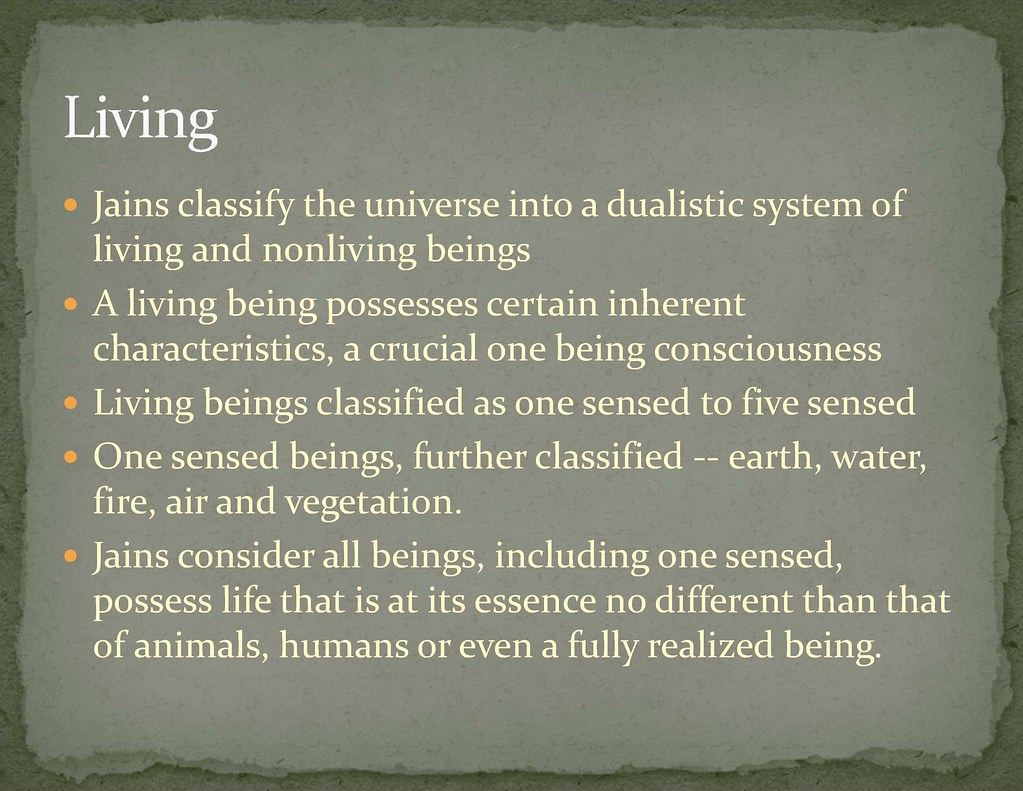 www.herenow4u.net/index.php?id=95811
www.herenow4u.net/index.php?id=95811
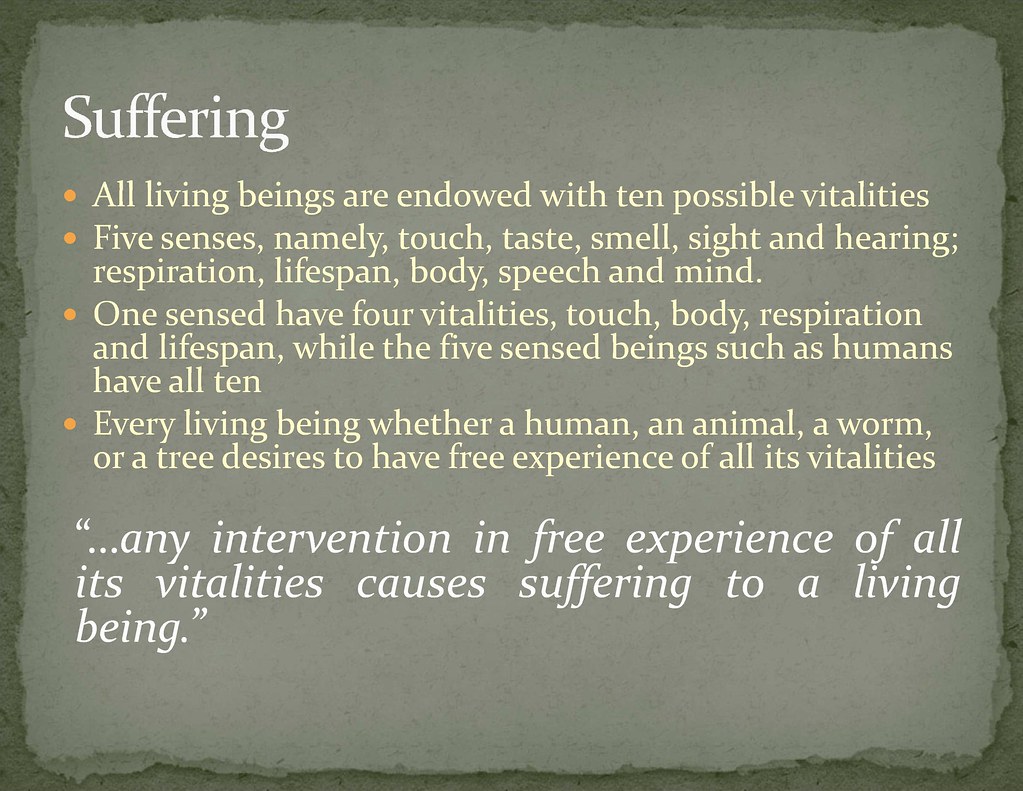 www.herenow4u.net/index.php?id=95811
www.herenow4u.net/index.php?id=95811
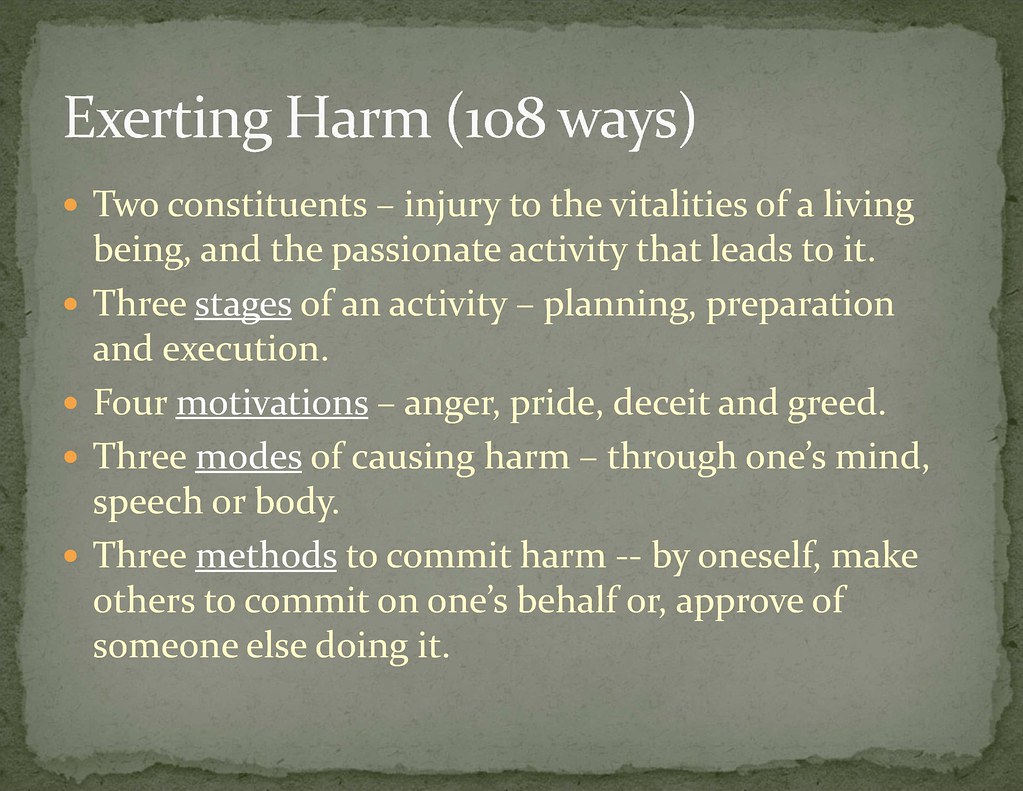 www.herenow4u.net/index.php?id=95811
www.herenow4u.net/index.php?id=95811
pp. 52-62, Autumn 1967.
Hugh (ed.). Ethics in Practice: Third Edition. Malden, MA: Blackwell. pp. 171-180. 1974.
Bombay, India pp. 23. 1917.
 Dr. Nirmal Baid
Dr. Nirmal Baid

